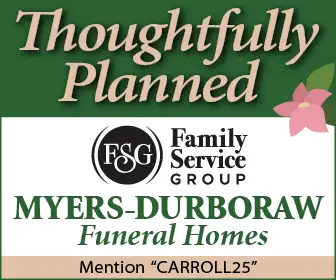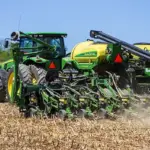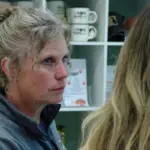by Amanda Milewski, photography by Nikola Tzenov
Recognizing Some Of The County’s Shadiest Specimens
In a county known for its farmland and agrarian history, where Maryland agricultural license plates abound and where you can easily get stuck behind a harvester creeping along a county road, you might not even see the forest, let alone the trees.
But for Geary Schwemmer, trees are always top of mind. And it’s not because that’s his business, it’s because he is the head of Carroll County’s Big Tree Program, treasurer of the
Carroll County Forestry Board and a recent addition to the state Big Tree Committee.
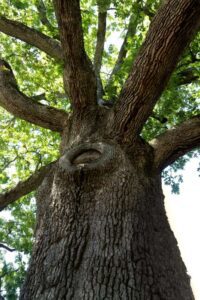 A county resident since 1986, Schwemmer worked for NASA and then in private industry in laser remote sensing and photonics before his retirement. Schwemmer credits his wife, Sharon, an avid naturalist, as a force behind his interest in trees, as well as years of planting and caring for trees on their property. Upon retiring, he began volunteering with The American Chestnut Foundation (TACF), an organization dedicated to reviving the species that was decimated by a deadly blight around the turn of the 20th century. “I started receiving a newsletter from The American Chestnut Foundation and through a link on their newsletter, I learned of the Big Tree Program,” Schwemmer recalled.
A county resident since 1986, Schwemmer worked for NASA and then in private industry in laser remote sensing and photonics before his retirement. Schwemmer credits his wife, Sharon, an avid naturalist, as a force behind his interest in trees, as well as years of planting and caring for trees on their property. Upon retiring, he began volunteering with The American Chestnut Foundation (TACF), an organization dedicated to reviving the species that was decimated by a deadly blight around the turn of the 20th century. “I started receiving a newsletter from The American Chestnut Foundation and through a link on their newsletter, I learned of the Big Tree Program,” Schwemmer recalled.
A lifelong lover of travel and trees — “I was an avid tree climber as a child,” he joked — Schwemmer kept busy during the COVID-19 lockdown by riding his motorcycle to view and hike around some of the Big Trees on the county’s and Maryland’s registries. When he noticed some incorrect GPS coordinates linked to the trees’ locations as well as some missing or dead trees, he contacted the heads of the Maryland Big Tree Program, who didn’t hesitate to let him know that help was needed in Carroll County. Schwemmer gladly stepped up and now he is the big cheese of Carroll’s big trees.
Carroll has 61 trees listed with the Maryland Big Tree Program. Five are state champions and one is a national champion. The trees are located on both public and private property; five are publicly accessible. Champions remain on the list until another of the same species outscores it.
Trees are scored by a formula developed by Maryland’s first forester, Fred Besley. The formula is: the tree’s circumference in inches + its height in feet + one-quarter of its average crown spread = total points. The circumference generally is measured 4 feet 6 inches above ground level. “Besley began searching for and measuring champion trees in 1925,” Schwemmer said.
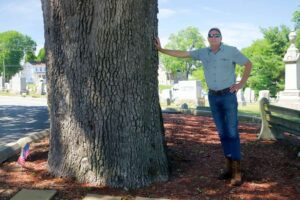
Trees can be nominated for Big Tree status by anyone — the tree’s owner, a neighbor, someone who is just passing by, and sometimes even Schwemmer himself. Volunteers from the Big Tree Program will come out to measure the tree, but they do request that the tree be at least 70 percent of that species’ state champion to qualify to be measured. And of course, trees located on private property will need the owners’ approval before volunteers can access them.
The largest tree in the county, and a county champion of course, is a silver maple located in Westminster, which scored 382 points. Its circumference is 272 inches, its height is 77 feet and its crown width is 120 feet.
State champion trees located in the county include a black mulberry in Westminster, scoring 360 points; a sugar maple, also in Westminster, scoring 287 points; a weeping Yoshino cherry, located in New Windsor, scoring 275 points; a Hinoki cypress, located in New Windsor, scoring 205 points; a saucer magnolia in Hampstead, also scoring 205 points; and a white cedar located in Sykesville, scoring 199 points.
Carroll’s solitary national champion tree is that black mulberry in Westminster. Including the mulberry, Maryland has 21 national champion trees.

From 2010 to 2020, the year Schwemmer volunteered to lead Carroll’s Big Tree Program, only 17 trees were nominated for the program. He was happy to report that in 2020, 13 trees were nominated and in 2021, 26 were nominated. So, although awareness and recognition of Carroll’s Big Trees appears to be growing, Schwemmer said that, “We’re trying to get more trees identified on public property so that citizens can visit them easily. For those champion trees on private property, we are not allowed to divulge the location of the tree to the public.”
For county residents who want to nominate a tree — either one of their own or a neighbor’s or one on public property — there is a nomination form online. “A tree in good health is preferred,” said Schwemmer, “but we will measure most nominations that appear to qualify.”
Having a tree in the program, “gives tree owners bragging rights,” he said, “and helps create a better appreciation for what trees provide us with. Hopefully, [learning more about the Big Tree Program] sparks an interest in learning more about the workings of trees, caring for them, their plight and how it impacts us — global warming, for example.”
Schwemmer explained that the Big Tree Program was once operated by employees of the Department of Natural Resources but, for financial reasons, it transitioned to being run solely by volunteers at some point. “The program is always interested in finding new volunteers,” Schwemmer said. “Not every Maryland county has a Big Tree Program or a person who coordinates it. In those cases, volunteers from surrounding counties attempt to cover those areas.”
If you are interested in learning more about the county’s Big Trees, visit Carroll’s Forestry Board’s website at carrollcountyforestryboard.com. The website includes a listing of Carroll’s top 10 trees as well as photos of specimens that are biggest, tallest, fattest and have the largest crown spread. In addition, a Big Tree tour map is available to download, which includes a listing of the publicly accessible Big Trees, their addresses and GPS coordinates.
And who knows? You may have a county, state or national champion in your own backyard! For more information on the Maryland Big Tree Program, including details on the tree measurement formula and a downloadable Big Tree nomination form, visit mdbigtrees.org.




